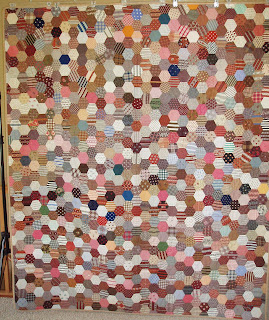 Just in time for winter here in Minnesota, our Land of Lakes Study Group met last Saturday to study wool quilts. I guess it was fitting that the day also brought our first real snowstorm. We didn't get many inches but it always takes a bit of getting used to - and it was slippery out there. One of our out-state members reported taking one hour to go seven miles and seeing eleven vehicles in the ditch!
Just in time for winter here in Minnesota, our Land of Lakes Study Group met last Saturday to study wool quilts. I guess it was fitting that the day also brought our first real snowstorm. We didn't get many inches but it always takes a bit of getting used to - and it was slippery out there. One of our out-state members reported taking one hour to go seven miles and seeing eleven vehicles in the ditch!We saw quilts from the late 1800's to the present time. Mary Chalmers started us off by sharing several of her award winning embroidered wool quilts. Several years ago she was inspired by article in an old quilt magazine and this is the result. She took off from there as you will see in the rest of her pieces! Who can tell where inspiration will take us!
 She does beautiful work. Watch for her pieces at major shows in the future.
She does beautiful work. Watch for her pieces at major shows in the future.  |
| Vibrant Fan Variation |
 |
| Mary pointed out that each block is really a pieced design and only the background is 'crazy'. The black sashing helps contain the excitement. |
 |
| The effort put into making a special border pays off |
I was excited to share this Churn Dash, a gift from long-time friends Sharon and Horace. I had admired it years ago as it hung on a wall in their home. Thanks to their urge to downsize (and a generous heart) it came to live with me.
 The 15" blocks are made of a variety of wools, wool blends, cottons and novelty weaves.
The 15" blocks are made of a variety of wools, wool blends, cottons and novelty weaves.Simple embroidered feather stitching in either white or yellow outlines each shape.
 |
| Top-stitched binding |

The back is pieced of colorful 8" squares; also in a variety of fabrics including blends, cottons, silks and wools.
Though it has quite a few condition issues, the graphic appeal and the vibrancy of the colors makes it an exciting piece.
My friend Judy let me show her beautiful family quilt. She believes it was made for her Grandparents for their wedding in 1916. The log cabin variation, known as 'Pineapple', is done on a foundation in a style sometimes called 'pressed' work. The generous 20" blocks are composed of 1/2" strips. Instead of pressing the seam all the way open, the fabric is folded back just enough to cover the seam allowance. This creates a slightly three dimensional look and adds some added texture. The back is a brown cotton print c. 1890.
 |
| Notice that the center block is slightly different than the rest - a subtle medallion setting! And check out that border. |
 |
| Detail of fine double row quilting Click to enlarge |
 |
| Visible moth damage and the printed cotton backing |
Gail shared this vibrant and graphic wool quilt which was bought as a top. Her daughter finished it by tying and gave it to her Dad for Christmas. It is used regularly.
 Kim Baird, from Fargo, ND, has been involved with the quilt documentation project in her state and active in many quilt related activities since the late 1970's.
Kim Baird, from Fargo, ND, has been involved with the quilt documentation project in her state and active in many quilt related activities since the late 1970's.She is particularly interested in the fan variation often called Wagon Wheel and shared many variations with us via Powerpoint.
Here's a lovely example from the quilt index.
This one-of-a kind fan variation is called Crazy Fans and is in the Henry Ford museum. They do look like wheels, don't they? It was made by Susan McCord.
 |
| c. 1895 |
 |
| HEY! Where am I? And I thought that was MY dress! |
And finally, a very utilitarian example from about 1950 which I slept under many times. It was made by our Aunt Agnes. I told you about her in the post about my Second Wedding Quilt. And that's my sister posing in front of it.
Neither of us knows what happened to the quilt but we do both remember that it was very heavy and that it kept sliding off the bed because the back was something slippery. I guess we never thought about about using it face down!
If you have thought of wool quilts as strictly utilitarian - everyday rather than fancy - some of these examples tell a different story. As a natural fiber, wool takes dyes beautifully and gives a lustrous appearance not to mention the instant warmth such a quilt provides.
On the down side, it is prone to moth damage, a bit more challenging to clean compared to cotton and working with wool does present some unique challenges. But.....I'm inspired to add 'Wool Quilt" to my list of things to try - how about you?
Next: Just Two Colors - My Latest Additions

























































